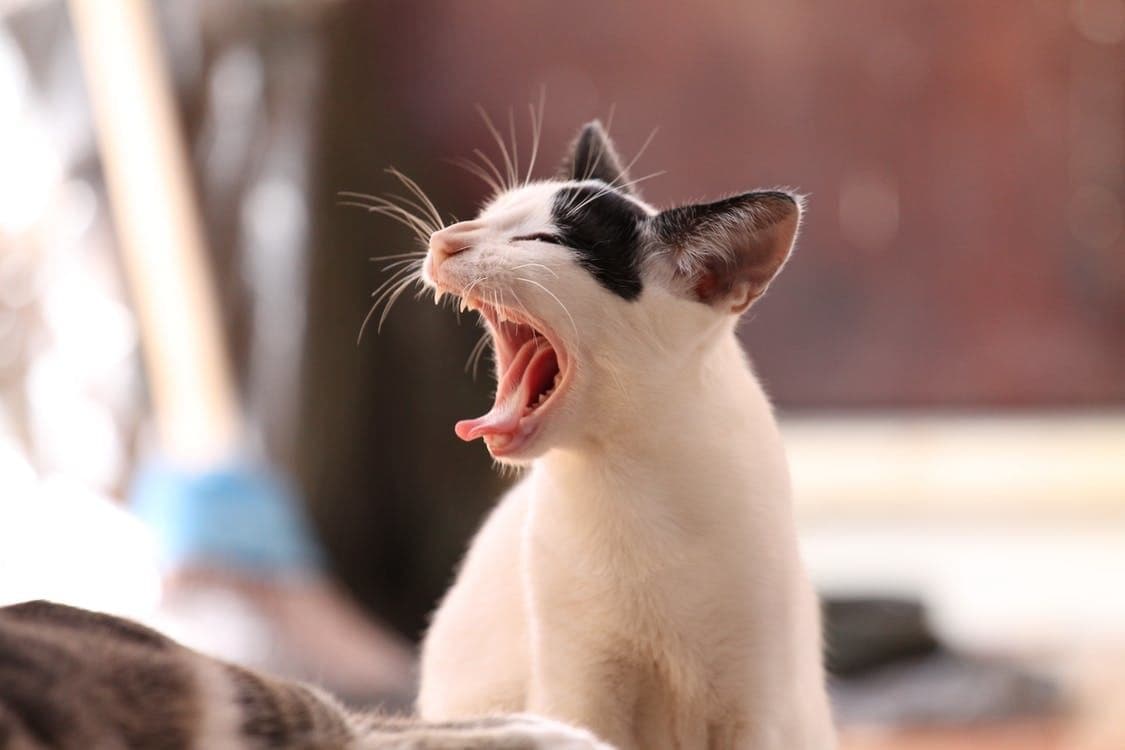Periodontal disease is an inflammatory disease of the gums, commonly diagnosed in cats, dogs, and people. If left untreated, it can cause severe pain, tooth loss, and can affect other organs, most notably the kidneys and heart valves. The early stage of gum inflammation (caused by plaque and tartar buildup) is commonly referred to as gingivitis. If left untreated, gingivitis can progress into an advanced stage of gum inflammation and destruction of the teeth’s support structure – periodontitis. Periodontitis and gingivitis both fall under the umbrella term ‘periodontal disease’.
Test Your Cat's Risk for Periodontal Disease NOW
Causes and progression of periodontal disease in cats
Gingivitis occurs due to plaque – a biofilm formed by microbes and saliva in the mouth. Biofilms are slimy microbial layers formed to allow bacteria and other microbes to stay together and stick to a surface in an environment in which they would otherwise be washed away. In the mouth, plaque allows microbes to stick onto the teeth and remain in the mouth where they feed, grow, and multiply.
As plaque accumulates, it will start mineralizing into a hard, brownish structure called tartar. Tartar provides a more rigid surface onto which plaque can stick more securely. While plaque can be easily removed by regular (read daily!) and thorough tooth brushing, tartar is much more difficult to remove and often requires professional cleaning.
As they accumulate, plaque and tartar eventually lead to gum inflammation. The early stage of gum inflammation – gingivitis – is accompanied by red, swollen, and painful gums. If plaque is not removed, it will continue to accumulate, and gingivitis will progress into periodontitis. Gums will become even more painful, often bleeding, and they might start pulling away from the teeth. This can result in loose adhesion of the gums to the teeth and, eventually, tooth loss. In the final stages of the disease, plaque microbes may reach the bloodstream and cause damage to the kidneys and other organs.
Symptoms and diagnosis of periodontal disease in cats
As periodontal disease is caused by plaque buildup, the first thing you might notice is the accumulation of plaque and tartar on your cat's teeth. If left untreated, you might start noticing that the gums surrounding the teeth are becoming redder and more swollen in appearance. As the inflammation progresses, the gums may become bloody and very painful. Affected cats may exhibit signs of pain while eating and lose their appetite. Another common symptom of periodontal disease is bad breath (halitosis).
Treatment and prognosis of periodontal disease in cats
The treatment and prognosis of periodontal disease in cats largely depends on the stage at which it was caught. If caught early (at the gingivitis stage), the prognosis is usually very good. A vet will likely advise professional teeth cleaning, followed by treatment of the inflammation. More advanced stages of diseases, however, may be more difficult to treat. Your vet will have to carefully examine your cat's teeth to determine the severity of inflammation in order to design an appropriate treatment plan.
Once the teeth have been cleaned by a professional and the inflammatory process is under control, you will be advised to continue regularly cleaning your cat's teeth to prevent the disease from recurring.
Prevention of dental diseases in cats
Fortunately, periodontal disease can often be prevented by regular tooth brushing. If you regularly clean your cat's teeth, you will prevent the plaque from accumulating and mineralizing into tartar. You will also offer your cat a better chance of staying safe from gingivitis and periodontitis.
We know that tooth brushing in cats sounds like an incredibly difficult task. But, with a few simple tricks, you can train your cat to accept the process as part of their daily routine. It is usually easier to get cats accustomed to the teeth cleaning routine early on in life. However, adult cats can also be trained to accept teeth cleaning as a normal part of their day. Here is our guide through feline oral hygiene to help you get started on the journey!
Being as common as they are, dental diseases are one of the most frequent health struggles for all pet owners. Luckily, dental diseases are largely preventable by including just a few good practices in your everyday cat care routine. Have you already trained your cat to accept regular teeth cleaning? Share your tips and tricks with us in comments!


